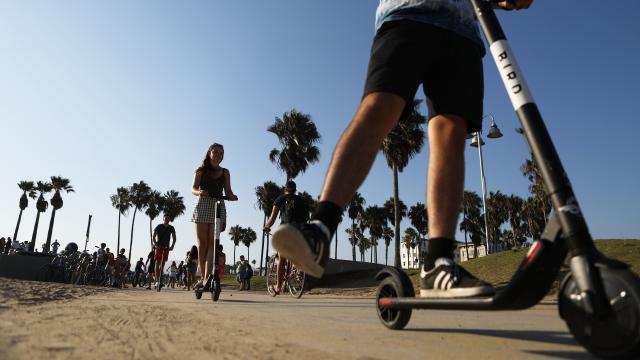Electric scooters have become wildly popular overseas, thanks to single-named companies like Bird, Scoot, and Lime creating easy-to-ride, if legally iffy, scooter rental services in cities across the U.S and even New Zealand. But a new study out Friday is seemingly the first to quantify a drawback to these convenient devices: Lots of riders are getting hurt and ending up in the emergency room.
The e-scooter craze can be traced back entirely to California. In the fall of 2017, the company Lime began offering a dockless, scooter rental service (operated via app) in San Francisco; Bird soon followed with its own version in Santa Monica. Despite eventually incurring the wrath of local city governments over having put thousands of scooters on streets with no permission, the e-scooters took off in popularity.
(Both cities temporarily banned e-scooters, but have since started pilot programs for certain companies.)
As it turns out, the researchers behind the current study, published Friday in JAMA Network Open, were all based at the University of California, Los Angeles, giving them a up-close look at the trend as it took off.
They decided to examine medical records from the emergency departments of two hospitals affiliated with UCLA, including one in Santa Monica. They singled out cases that took place between September 1, 2017 to August 31, 2018, using search terms such as “scooter”, “Bird”, and “Lime”, to find them.
All told, there were 249 people who visited these emergency rooms with injuries associated with e-scooters within that year. The vast majority, 91 per cent, had gotten hurt while riding, usually by falling. And some got seriously hurt.
“Although only six per cent of patients were admitted to the hospital, nearly 1 in 3 patients arrived by ambulance. 80 per cent had an imaging test (x-rays or CT-scans), and fractures and head injuries were common among ED patients,” lead author Tarak Trivedi, an emergency medicine physician at Ronald Reagan UCLA Medical Center, told Gizmodo via email.
Trivedi and his team also conducted a simple, observational survey of nearly 200 scooter riders in the wild, looking to see whether riders were being safe. Barely 5 per cent of these riders used helmets (a similar percentage of riders in the emergency department reported helmet use, though helmet status was unknown in 63 per cent of cases).
Just over a quarter of riders rode on the footpath, a legal no-no in most areas, while 9 per cent broke traffic laws and 8 per cent rode with someone in the back. Eleven per cent were also under the age of 18, flouting the age and licence restrictions set by companies like Bird and Lime.
Doctors have voiced concerns about e-scooter injuries before. But the study’s findings, according to the authors, are the first to document the extent of these injuries in the ED. At this point, Trivedi said, there’s no clear way to know how commonly these injuries are happening, even in their study, because we don’t know how many people are riding in a specific area.
For some context, Bird recently announced that it had hit 10 million rides this past September, while Lime announced 11.5 million rides across its scooters and bikes combined.
The authors aren’t trying to stop the e-scooter buzz; Trivedi himself even uses one regularly. But there are definitely things companies and cities should be doing to mitigate the risk of injury.
“Our study didn’t have the ability to assess the role of damaged or malfunctioning scooters in scooter accidents. However as an e-scooter rider, I know that the accelerators and brakes on the scooters can sometimes ‘stick’; this is something that patients have shared with me as well in the [emergency department],” he said.
“Scooter companies could make reporting damaged scooters easier in the app, and work to minimise the number of malfunctioning scooters on the road. Cities could consider expanding protected lanes, so that scooter riders, bicyclists, and pedestrians can all be safer.”
Another way companies could help researchers like Trivedi is by sharing mileage data so it’d be easier to quantify the injury rate of scooter use. That would let them better understand just how risky these devices generally are. Trivedi and his colleagues may also look at outpatient visits related to e-scooter injuries in the near future, filling in more gaps.
Of course, there are clearly things e-scooter riders themselves could be doing to stay safe.
“While electric scooters are convenient, useful, and fun to use, people should take safety seriously when using electric scooters.” Trivedi said.
Those tips, as might be obvious, include wearing a helmet, staying off the footpaths to avoid hurting other people, and sticking to one person per scooter. These are all tips we should keep in mind if the scooters make the jump over to Australia.
